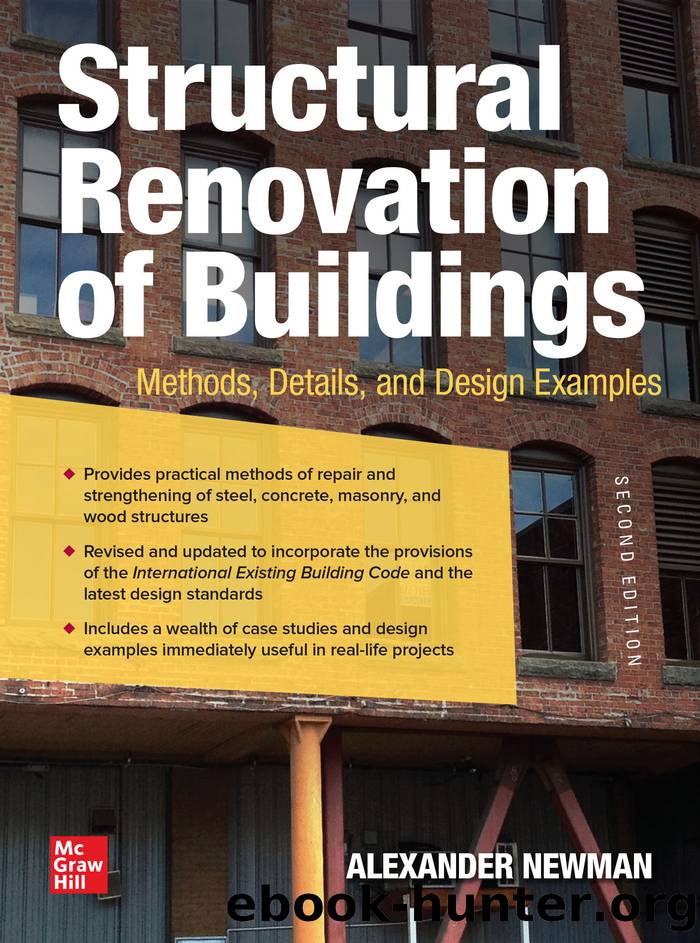Structural Renovation of Buildings: Methods, Details, and Design Examples, Second Edition by Alexander Newman

Author:Alexander Newman
Language: eng
Format: epub
Publisher: McGraw-Hill Education LLC
Published: 2021-11-15T00:00:00+00:00
When there is a relatively high level of certainty that damage, even if severe, is localized, replacement could include only the affected tendons. The basic technique for replacing tendons, few or many, is the same: The damaged member is shored, the tendons detensioned, the anchors removed and replaced, the concrete and steel around the anchors repaired and given additional protection from corrosion, and new tendons installed and stressed. The actual tendon removal can be done from the anchor locations, from the middle of the member, or from some other point. These steps are further described in Sec. 7.8.
When single-strand tendons are replaced, the new ones can be threaded through the existing plastic sheathing, if its shape is approximately round. Since the sheathing may not survive the operation intact, or could have already been damaged, some experts recommend giving the replacement tendons a 30-mil epoxy coating for corrosion protection.17 Replacing the tendons in a paper-wrapped wire system is much more difficult because it involves inserting new tendons into the existing ducts of irregular cross section. In that case, the trenching method might be the most practical.
Kesner and Poston10 suggest that when replacement of a post- tensioning system is required, the new system need not necessarily mimic the existing one. It could be beneficial to change the tendon layout to a more efficient one. For example, a floor that is post-tensioned in two directions could be replaced with a one-way banded post- tensioned system, a simple and practical solution. Moreover, repairs to modestly deteriorated post-tensioned structures might not be even needed in some cases. Kesner and Poston point out that the ACI Building Code (ACI 31818) allows for up to a 2 percent loss of prestress force âdue to unreplaced broken tendons.â This provision can presumably be applied to repair work. Thus, if only one or two of the hundreds of tendons are damaged, the structure might be considered adequate without strengthening. Also, higher effective steel stresses could probably be assumed for the tendons used in repairs. The reason: Most post-tensioning losses typically result from concrete shrinkage and creep, which would have largely taken place by the time of the repair work. It is also possible that the existing tendons might have been tensioned to a larger degree than necessary. All these factors could help reduce the number of the repaired or replaced tendons, or provide justification for leaving the existing tendons in place. Of course, careful investigation and analysis by qualified engineers is required to determine if any of these factors apply.
This approach is more appropriate when easy-to-see mechanical damage has occurred, rather than hidden deterioration resulting from corrosion, for the simple reason that in the case of corrosion, no one can be certain how many tendons are damaged. Also, some tendons are located in more critical areas than others.19
Sometimes internal tendon replacement is not practical because of budgetary constraints, drastic increases in loading, or the practical impossibility of installing new tendons into the existing tendon ducts. When the traditional post-tensioning
Download
This site does not store any files on its server. We only index and link to content provided by other sites. Please contact the content providers to delete copyright contents if any and email us, we'll remove relevant links or contents immediately.
Whiskies Galore by Ian Buxton(41797)
Introduction to Aircraft Design (Cambridge Aerospace Series) by John P. Fielding(33044)
Small Unmanned Fixed-wing Aircraft Design by Andrew J. Keane Andras Sobester James P. Scanlan & András Sóbester & James P. Scanlan(32730)
Craft Beer for the Homebrewer by Michael Agnew(18122)
Turbulence by E. J. Noyes(7918)
The Complete Stick Figure Physics Tutorials by Allen Sarah(7290)
Kaplan MCAT General Chemistry Review by Kaplan(6849)
The Thirst by Nesbo Jo(6806)
Bad Blood by John Carreyrou(6518)
Modelling of Convective Heat and Mass Transfer in Rotating Flows by Igor V. Shevchuk(6375)
Learning SQL by Alan Beaulieu(6192)
Weapons of Math Destruction by Cathy O'Neil(6116)
Man-made Catastrophes and Risk Information Concealment by Dmitry Chernov & Didier Sornette(5899)
Digital Minimalism by Cal Newport;(5632)
Life 3.0: Being Human in the Age of Artificial Intelligence by Tegmark Max(5446)
iGen by Jean M. Twenge(5351)
Secrets of Antigravity Propulsion: Tesla, UFOs, and Classified Aerospace Technology by Ph.D. Paul A. Laviolette(5298)
Design of Trajectory Optimization Approach for Space Maneuver Vehicle Skip Entry Problems by Runqi Chai & Al Savvaris & Antonios Tsourdos & Senchun Chai(4995)
Electronic Devices & Circuits by Jacob Millman & Christos C. Halkias(4887)
